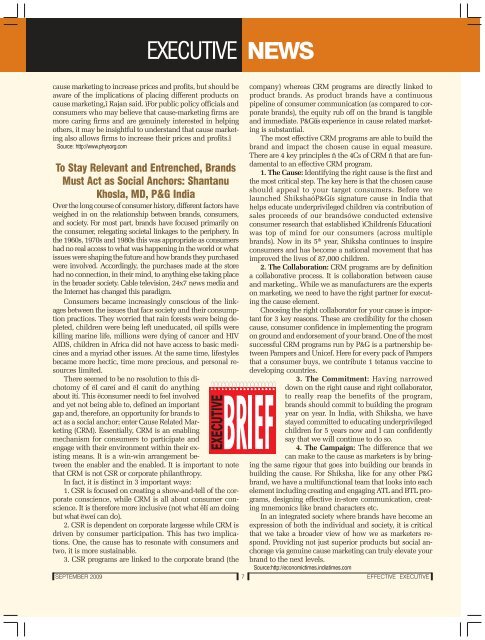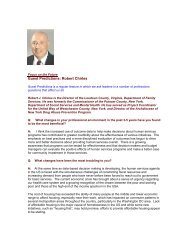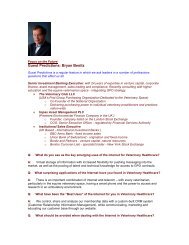Social Cause Marketing - The Regis Group Inc
Social Cause Marketing - The Regis Group Inc
Social Cause Marketing - The Regis Group Inc
You also want an ePaper? Increase the reach of your titles
YUMPU automatically turns print PDFs into web optimized ePapers that Google loves.
EXECUTIVE<br />
NEWS<br />
cause marketing to increase prices and profits, but should be<br />
aware of the implications of placing different products on<br />
cause marketing,î Rajan said. ìFor public policy officials and<br />
consumers who may believe that cause-marketing firms are<br />
more caring firms and are genuinely interested in helping<br />
others, it may be insightful to understand that cause marketing<br />
also allows firms to increase their prices and profits.î<br />
Source: http://www.physorg.com<br />
To Stay Relevant and Entrenched, Brands<br />
Must Act as <strong>Social</strong> Anchors: Shantanu<br />
Khosla, MD, P&G India<br />
Over the long course of consumer history, different factors have<br />
weighed in on the relationship between brands, consumers,<br />
and society. For most part, brands have focused primarily on<br />
the consumer, relegating societal linkages to the periphery. In<br />
the 1960s, 1970s and 1980s this was appropriate as consumers<br />
had no real access to what was happening in the world or what<br />
issues were shaping the future and how brands they purchased<br />
were involved. Accordingly, the purchases made at the store<br />
had no connection, in their mind, to anything else taking place<br />
in the broader society. Cable television, 24x7 news media and<br />
the Internet has changed this paradigm.<br />
Consumers became increasingly conscious of the linkages<br />
between the issues that face society and their consumption<br />
practices. <strong>The</strong>y worried that rain forests were being depleted,<br />
children were being left uneducated, oil spills were<br />
killing marine life, millions were dying of cancer and HIV<br />
AIDS, children in Africa did not have access to basic medicines<br />
and a myriad other issues. At the same time, lifestyles<br />
became more hectic, time more precious, and personal resources<br />
limited.<br />
<strong>The</strong>re seemed to be no resolution to this dichotomy<br />
of ëI careí and ëI canít do anything<br />
about ití. This ëconsumer needí to feel involved<br />
and yet not being able to, defined an important<br />
gap and, therefore, an opportunity for brands to<br />
act as a social anchor; enter <strong>Cause</strong> Related <strong>Marketing</strong><br />
(CRM). Essentially, CRM is an enabling<br />
mechanism for consumers to participate and<br />
engage with their environment within their existing<br />
means. It is a win-win arrangement between<br />
the enabler and the enabled. It is important to note<br />
that CRM is not CSR or corporate philanthropy.<br />
In fact, it is distinct in 3 important ways:<br />
1. CSR is focused on creating a show-and-tell of the corporate<br />
conscience, while CRM is all about consumer conscience.<br />
It is therefore more inclusive (not what ëIí am doing<br />
but what ëweí can do).<br />
2. CSR is dependent on corporate largesse while CRM is<br />
driven by consumer participation. This has two implications.<br />
One, the cause has to resonate with consumers and<br />
two, it is more sustainable.<br />
3. CSR programs are linked to the corporate brand (the<br />
SEPTEMBER 2009<br />
7<br />
company) whereas CRM programs are directly linked to<br />
product brands. As product brands have a continuous<br />
pipeline of consumer communication (as compared to corporate<br />
brands), the equity rub off on the brand is tangible<br />
and immediate. P&Gíís experience in cause related marketing<br />
is substantial.<br />
<strong>The</strong> most effective CRM programs are able to build the<br />
brand and impact the chosen cause in equal measure.<br />
<strong>The</strong>re are 4 key principles ñ the 4Cs of CRM ñ that are fundamental<br />
to an effective CRM program.<br />
1. <strong>The</strong> <strong>Cause</strong>: Identifying the right cause is the first and<br />
the most critical step. <strong>The</strong> key here is that the chosen cause<br />
should appeal to your target consumers. Before we<br />
launched ShikshaóP&Gís signature cause in India that<br />
helps educate underprivileged children via contribution of<br />
sales proceeds of our brandsówe conducted extensive<br />
consumer research that established ìChildrenís Educationî<br />
was top of mind for our consumers (across multiple<br />
brands). Now in its 5 th year, Shiksha continues to inspire<br />
consumers and has become a national movement that has<br />
improved the lives of 87,000 children.<br />
2. <strong>The</strong> Collaboration: CRM programs are by definition<br />
a collaborative process. It is collaboration between cause<br />
and marketing.. While we as manufacturers are the experts<br />
on marketing, we need to have the right partner for executing<br />
the cause element.<br />
Choosing the right collaborator for your cause is important<br />
for 3 key reasons. <strong>The</strong>se are credibility for the chosen<br />
cause, consumer confidence in implementing the program<br />
on ground and endorsement of your brand. One of the most<br />
successful CRM programs run by P&G is a partnership between<br />
Pampers and Unicef. Here for every pack of Pampers<br />
that a consumer buys, we contribute 1 tetanus vaccine to<br />
developing countries.<br />
3. <strong>The</strong> Commitment: Having narrowed<br />
down on the right cause and right collaborator,<br />
to really reap the benefits of the program,<br />
brands should commit to building the program<br />
year on year. In India, with Shiksha, we have<br />
stayed committed to educating underprivileged<br />
children for 5 years now and I can confidently<br />
say that we will continue to do so.<br />
4. <strong>The</strong> Campaign: <strong>The</strong> difference that we<br />
can make to the cause as marketers is by bringing<br />
the same rigour that goes into building our brands in<br />
building the cause. For Shiksha, like for any other P&G<br />
brand, we have a multifunctional team that looks into each<br />
element including creating and engaging ATL and BTL programs,<br />
designing effective in-store communication, creating<br />
mnemonics like brand characters etc.<br />
In an integrated society where brands have become an<br />
expression of both the individual and society, it is critical<br />
that we take a broader view of how we as marketers respond.<br />
Providing not just superior products but social anchorage<br />
via genuine cause marketing can truly elevate your<br />
brand to the next levels.<br />
Source:http://economictimes.indiatimes.com<br />
EFFECTIVE EXECUTIVE








